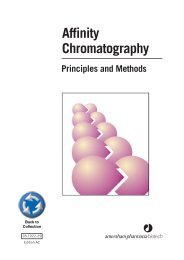Tabletop Rotors and Tubes
Tabletop Rotors and Tubes
Tabletop Rotors and Tubes
Create successful ePaper yourself
Turn your PDF publications into a flip-book with our unique Google optimized e-Paper software.
<strong>Tubes</strong> <strong>and</strong> Accessories<br />
kONICAL TUBES<br />
konical tubes, used with conical adapters in swinging bucket rotors to<br />
optimize pelleting separations, have a conical tip that concentrates the<br />
pellet in the narrow end of the tube. The narrow bottom also reduces<br />
the tube’s nominal volume <strong>and</strong> minimizes the amount of gradient<br />
material needed when pelleting through a dense cushion. They are<br />
available in polyallomer <strong>and</strong> Ultra-Clear. The konical tubes come<br />
in both open-top <strong>and</strong> Quick-Seal tube designs. The Quick-Seal type<br />
have bell-shaped tops to fit the floating spacers in the g-Max system<br />
for smaller volume runs with faster pelleting.<br />
TEMPERATURE LIMITS<br />
Each labware material has a specified temperature range. Although<br />
some ultracentrifuges can achieve temperatures as high as 45°C, only<br />
certain tube or bottle materials can be run under these conditions.<br />
Most containers are made of thermoplastic materials that soften at<br />
elevated temperatures. This temperature-induced softening, together<br />
with such factors as the centrifugal force, the run duration, the type of<br />
rotor, previous run history, <strong>and</strong> the tube angle, can cause labware to<br />
collapse. Therefore, if high-temperature runs—above 25°C—are<br />
required, it is best to pretest labware under the actual experimental<br />
conditions, using buffer or gradient of similar density rather than a<br />
valuable sample.<br />
• Plastic labware has been centrifuge tested for use at temperatures<br />
between 2 <strong>and</strong> 25°C. For centrifugation at other temperatures,<br />
pretest tubes under anticipated run conditions.<br />
• If plastic containers are frozen before use, make sure that they are<br />
thawed to at least 2°C prior to centrifugation.<br />
<strong>Tabletop</strong> Ultracentrifuge <strong>Rotors</strong> <strong>and</strong> <strong>Tubes</strong><br />
2-7

















